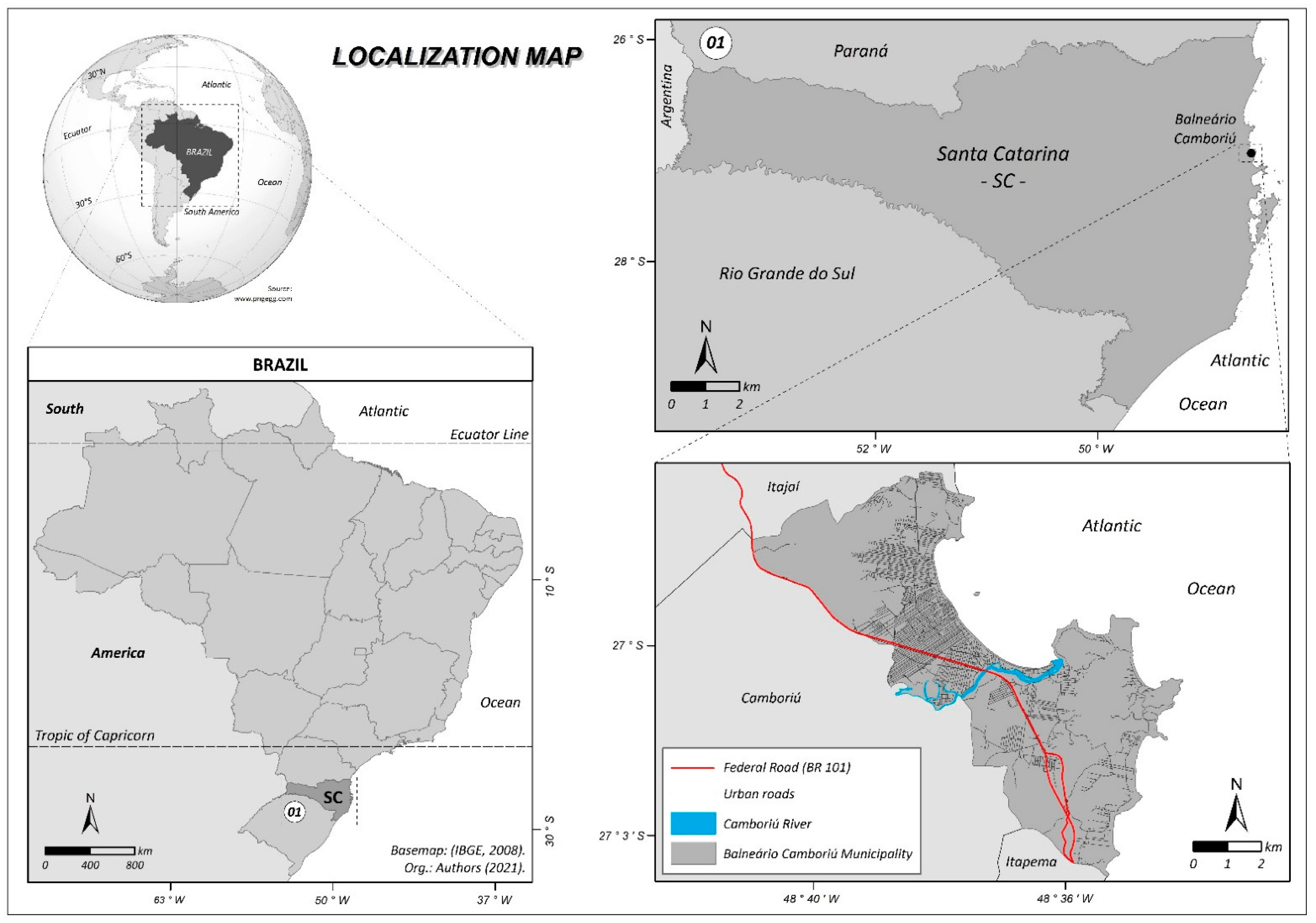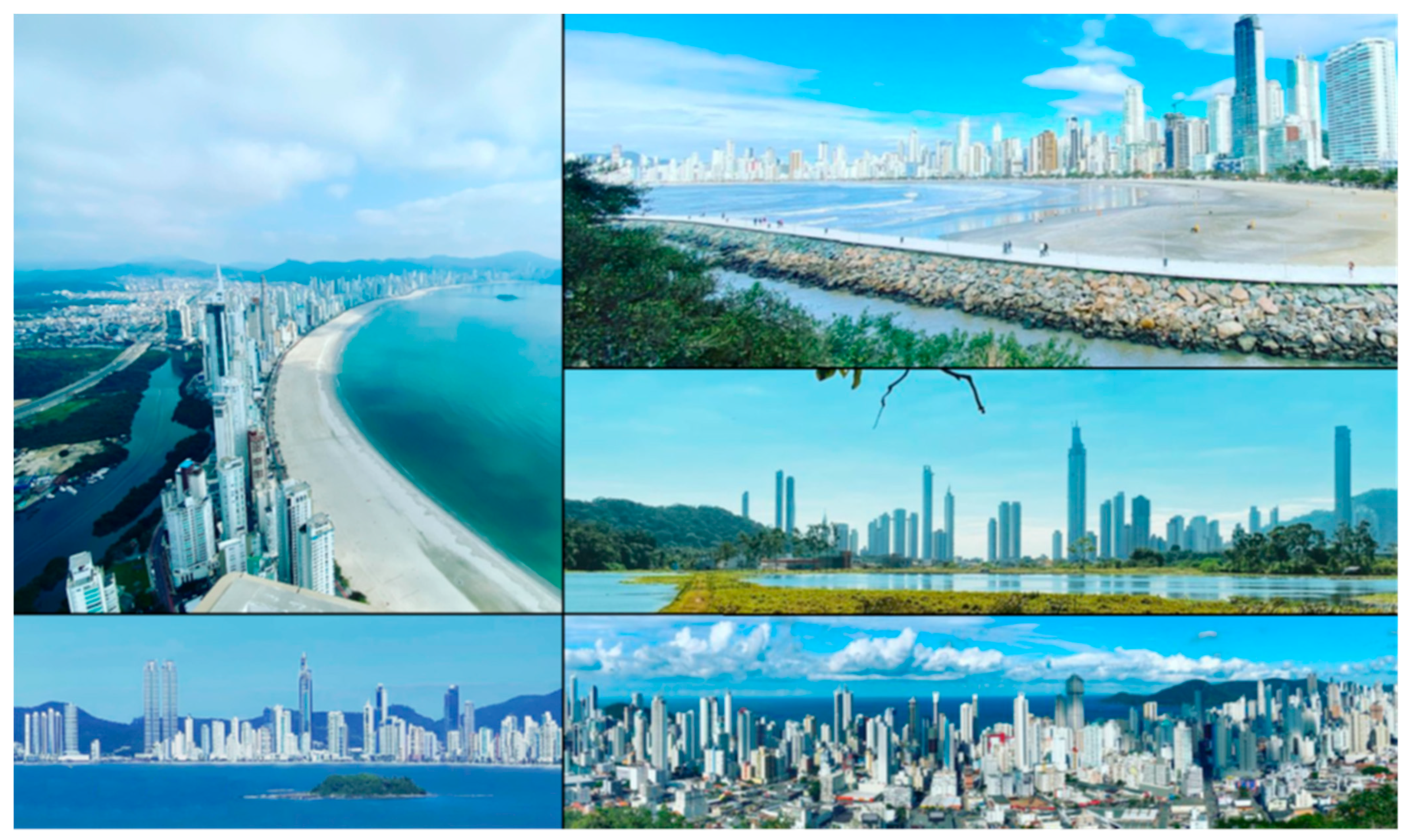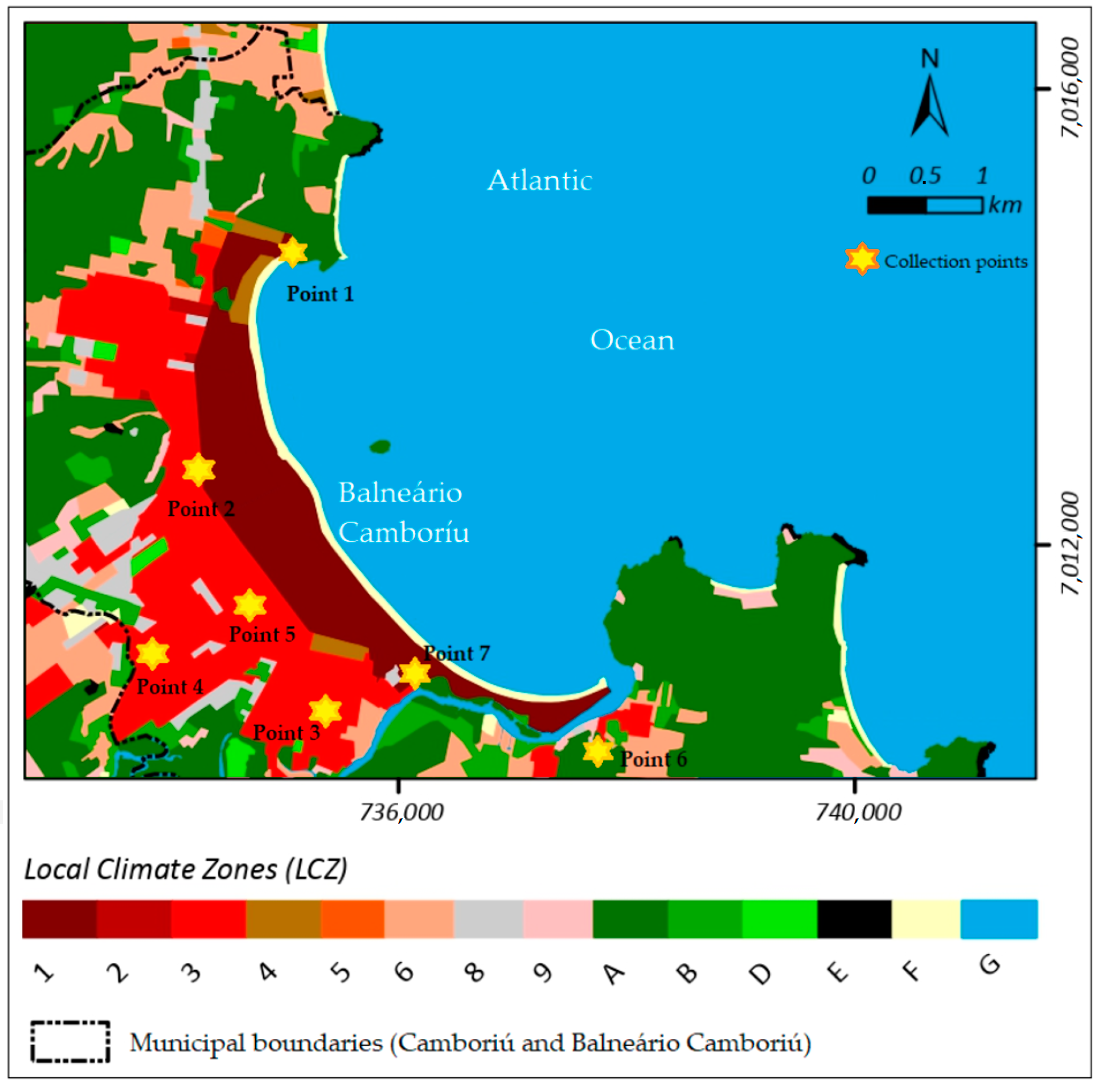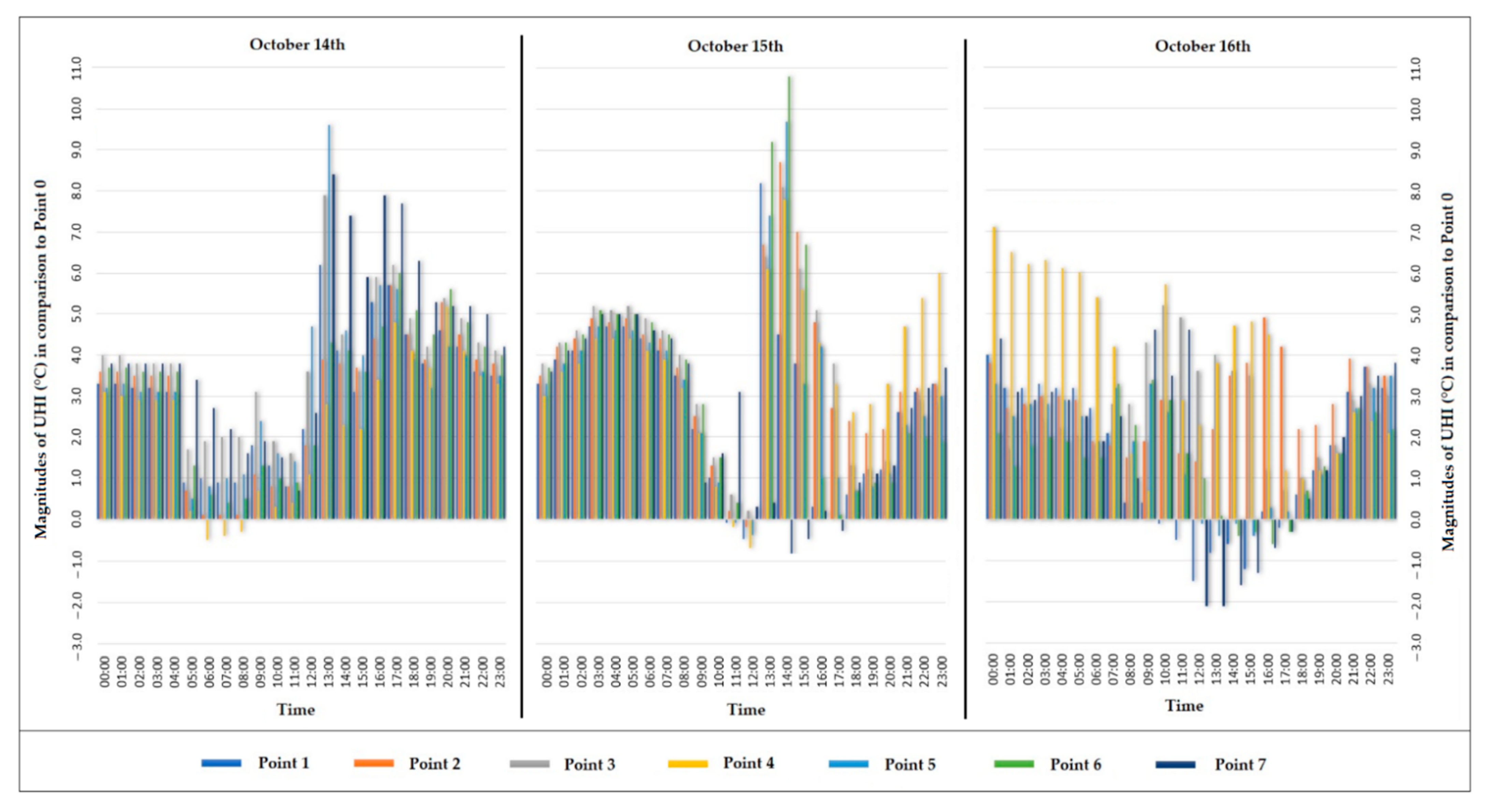Local Climate Zones, Sky View Factor and Magnitude of Daytime/Nighttime Urban Heat Islands in Balneário Camboriú, SC, Brazil
Abstract
1. Introduction
2. Materials and Methods
2.1. Study Area
2.2. Measuring Devices
2.3. Data Processing and Analysis
3. Results
3.1. Data Processing and Analysis
3.2. LCZs of Balneário Camboriú
3.3. Spatial Variation, Thermal Range and UHI
4. Discussion
Impact of Urban Morphology
5. Conclusions
Author Contributions
Funding
Informed Consent Statement
Acknowledgments
Conflicts of Interest
References
- Usamah, D.; Vijayalakshmi, P.; Mohammed, R. Changes in urban built-up and its impact on environment: A case study of Kanchipuram, Tamil Nadu, India. Disaster Adv. 2020, 13, 11–18. [Google Scholar] [CrossRef]
- Voelkel, J.; Shandas, V. Towards Systematic Prediction of Urban Heat Islands: Grounding Measurements, Assessing Modeling Techniques. Climate 2017, 5, 41. [Google Scholar] [CrossRef]
- Oke, T.R. The energetic basis of the urban UHI Quarterly. J. R. Meteorol. Soc. 1982, 108, 1–24. [Google Scholar] [CrossRef]
- Liang, Z.; Wu, S.; Wang, Y.; Wei, F.; Huang, J.; Shen, J.; Li, S. The relationship between urban form and UHI intensity along the urban development gradients. Sci. Total Environ. 2020, 708, 135011. [Google Scholar] [CrossRef]
- Stewart, I.D.; Oke, T.R. Local climate zones for urban temperature studies. Bull. Am. Meteorol. Soc. 2012, 93, 1879–1900. [Google Scholar] [CrossRef]
- Demuzere, M.; Kittner, J.; Bechtel, B. LCZ Generator: A Web Application to Create Local Climate Zone Maps. Front. Environ. Sci. 2021, 9, 637455. [Google Scholar] [CrossRef]
- Firdausah, A.M.; Wonorahardjo, S. Typology Study of Urban Canyon in Residential Area and The Quality of Its Thermal Environment. IOP Conf. Ser. Earth Environ. Sci. 2018, 152, 012025. [Google Scholar] [CrossRef]
- Marciotto, E.R. Impact of City Verticalization on the Urban Surface Energy Budget: A modeling study. In Proceedings of the Seventh International Conference on Urban Climate, Yokohama, Japan, 29 June–3 July 2009. [Google Scholar]
- Takkanon, P.; Chantarangul, P. Effects of urban geometry and green area on thermal condition of urban street canyons in Bangkok. Archit. Sci. Rev. 2019, 62, 35–46. [Google Scholar] [CrossRef]
- Choi, Y.; Lee, S.; Moon, H. Urban Physical Environments and the Duration of High Air Temperature: Focusing on Solar Radiation Trapping Effects. Sustainability 2018, 10, 4837. [Google Scholar] [CrossRef]
- Krüger, E.; Drach, P.; Emmanuel, R. Atmospheric Impacts on Daytime Urban Heat Island. Air. Soil Water Res. 2018, 11, 117862211881020. [Google Scholar] [CrossRef]
- Hu, Y.; Dai, Z.; Guldmann, J.-M. Modeling the impact of 2D/3D urban indicators on the urban heat island over different seasons: A boosted regression tree approach. J. Environ. Manag. 2020, 266, 110424. [Google Scholar] [CrossRef] [PubMed]
- Mirzaee, S.; Özgun, O.; Ruth, M.; Binita, K.C. Neighborhood-scale sky view factor variations with building density and height: A simulation approach and case study of Boston. Urban Clim. 2018, 26, 95–108. [Google Scholar] [CrossRef]
- Wollmann, C.A.; Hoppe, I.L.; Gobo JP, A.; Simioni JP, D.; Costa, I.T.; Baratto, J.; Shooshtarian, S. Thermo-Hygrometric Variability on Waterfronts in Negative Radiation Balance: A Case Study of Balneário Camboriú/SC, Brazil. Atmosphere 2021, 12, 1453. [Google Scholar] [CrossRef]
- IBGE Cidades@: Censo 2010. Available online: https://cidades.ibge.gov.br/brasil/sc/balneario-camboriu/panorama (accessed on 15 November 2020).
- Prefeitura Municipal De Balneário Camboriú. História do Município de Balneário Camboriú. Available online: https://www.bc.sc.gov.br/a-prefeitura.cfm (accessed on 5 September 2020).
- Alvares, C.A.; Stape, J.L.; Sentelhas, P.C.; Gonçalves, J.D.M.; Sparovek, G. Köppen’s climate classification map for Brazil. Meteorol. Z. 2013, 22, 711–728. [Google Scholar] [CrossRef] [PubMed]
- Esquina. Balneário Camboriú: Sucesso ou Catástrofe Urbana? Available online: http://www.esquina.net.br/2018/03/09/balneario-camboriu-sucesso-ou-catastrofeurbana (accessed on 23 June 2019).
- Amorim, M.C.C.T.; Dubreuil, V. Intensity of Urban Heat Islands in Tropical and Temperate Climates. Climate 2017, 5, 91. [Google Scholar] [CrossRef]
- Amorim, M.C.C.T. Spatial variability and intensity frequency of surface urban heat island in a Brazilian city with continental tropical climate through remote sensing. Remote Sens. Appl. Soc. Environ. Elsevier 2018, 9, 10–16. [Google Scholar] [CrossRef]
- Jain, M.; Pathak, K.K. Effect of urban morphology on subtropical humid microclimate: The case of Bhopal, India. Int. J. Recent Technol. Eng. 2019, 8, 2376–2382. [Google Scholar] [CrossRef]
- Hoppe, I.L.; Wollmann, C.A.; Baratto, J. Performance de um novo modelo de abrigo meteorológico de baixo custo. Caminhos De Geogr. 2022, 23, 71–84. [Google Scholar] [CrossRef]
- Debbage, N. Sky-view factor estimation: A case study of Athens, Georgia. Geogr. Bull.-Gamma Upsilon 2013, 54, 49–57. [Google Scholar]
- Barbosa, G.S.; Drach, P.C.; Corbella, O.D. Intraurban Temperature Variations: Urban Morphologies of the Densification Process of Copacabana Neighborhood, Brazil. Climate 2019, 7, 65. [Google Scholar] [CrossRef]
- Quan, J. Multi-Temporal Effects of Urban Forms and Functions on Urban Heat Islands Based on Local Climate Zone Classification. Int. J. Environ. Res. Public Health 2019, 16, 2140. [Google Scholar] [CrossRef] [PubMed]
- Mandelmilch, M.; Ferenz, M.; Mandelmilch, N.; Potchter, O. Urban Spatial Patterns and Heat Exposure in the Mediterranean City of Tel Aviv. Atmosphere 2020, 11, 963. [Google Scholar] [CrossRef]
- Xue, J.; You, R.; Liu, W.; Chen, C.; Lai, D. Applications of Local Climate Zone Classification Scheme to Improve Urban Sustainability: A Bibliometric Review. Sustainability 2020, 12, 8083. [Google Scholar] [CrossRef]
- Emmanuel, R.; Krüger, E. Urban heat island and its impact on climate change resilience in a shrinking city: The case of Glasgow, UK. Build. Environ. 2012, 53, 137–149. [Google Scholar] [CrossRef]
- Cardoso, R.; Amorim, M. Estimativa da distribuição espacial da temperatura do ar com base em zonas climáticas locais (LCZ) e modelos de regressão. Rev. De Geogr. E Ordenam. Do Territ. 2017, 1, 75–99. [Google Scholar] [CrossRef]
- Stewart, I.D. A systematic review and scientific critique of methodology in modern urban heat island literature. Int. J. Climatol. 2011, 31, 200–217. [Google Scholar] [CrossRef]
- Yan, H.; Wu, F.; Nan, X.; Han, Q.; Shao, F.; Bao, Z. Influence of view factors on intra-urban air temperature and thermal comfort variability in a temperate city. Sci. Total Environ. 2022, 841, 156720. [Google Scholar] [CrossRef]
- Zhang, Q.; Wu, Z.; Guo, G. The cooling effect of water landscape in high-density urban built-up area a case study of the center urban district of Guangzhou. In Proceedings of the 2017 2nd International Conference on Frontiers of Sensors Technologies (ICFST), Shenzhen, China, 14–16 April 2017; pp. 394–400. [Google Scholar]
- Gupta, N.; Mathew, A.; Khandelwal, S. Analysis of cooling effect of water bodies on land surface temperature in nearby region: A case study of Ahmedabad and Chandigarh cities in India. Egypt. J. Remote Sens. Space Sci. 2019, 22, 81–93. [Google Scholar] [CrossRef]
- Cilek, M.U.; Cilek, A. Analyses of land surface temperature (LST) variability among local climate zones LCZs) comparing Landsat-8 and ENVI-met model data. Sustain. Cities Soc. 2021, 69, 102877. [Google Scholar] [CrossRef]
- Choudhury, D.; Das, A.; Das, M. Investigating thermal behavior pattern (TBP) of local climatic zones (LCZs): A study on industrial cities of Asansol-Durgapur development area (ADDA), eastern India. Urban Climate 2021, 35, 100727. [Google Scholar] [CrossRef]
- Yuan, B.; Zhou, L.; Hu, F.; Zhang, Q. Diurnal dynamics of heat exposure in Xi’an: A perspective from local climate zone. Building and Environment 2022, 222, 109400. [Google Scholar] [CrossRef]
- Gagliano, A.; Nocera, F.; Aneli, S. Computational Fluid Dynamics Analysis for Evaluating the Urban Heat Islands Effects. Energy Procedia 2017, 134, 508–517. [Google Scholar] [CrossRef]
- Leal-Filho, W.; Echevarria Icaza, L.; Emanche, V.O.; Zheng, Y.; Ren, C.; Xu, Y.; Wang, R.; Ho, J.; Lau, K.; Ng, E. GIS-based mapping of Local Climate Zone in the high-density city of Hong Kong. Urban Clim. 2018, 24, 419–448. [Google Scholar] [CrossRef]
- Juruš, P.; Resler, J.; Derbek, P.; Krč, P.; Belda, M.; Benešová, N.; Vlček, O.; Srbová, D.; Eben, K.; Hrubeš, P. High resolution modelling of anthropogenic heat from traffic in urban canopy: A sensitivity study. In Proceedings of the 2016 Smart Cities Symposium Prague SCSP, Prague, Czech Republic, 26–27 May 2016; p. 7501031. [Google Scholar]
- Nakata-Osaki, C.M.; Souza, L.C.L.; Rodrigues, D.S. A GIS extension model to calculate urban heat island intensity based on urban geometry. In Proceedings of the 14th International Conference on Computers in Urban Planning and Urban Management, Cambridge, MA, USA, 7–10 July 2015; pp. 1–16. [Google Scholar]
- Oke, T.R. Boundary Layer Climates, 2nd ed.; Cambridge University Press: Cambridge, UK, 1993. [Google Scholar]
- Anjos, M.; Lopes, A. Urban heat island Park Cool Island Intensities in the Coastal City of Aracaju, North-Eastern Brazil. Sustainability 2017, 9, 1379. [Google Scholar] [CrossRef]












| Point | LCZ Class | LCZ Name | Description of LCZ—Land Cover Types |
|---|---|---|---|
| 0 | D | Low plants | Featureless landscape of grass or herbaceous plants/crops. Few or no trees. Zone function is natural grassland, agriculture, or urban park. |
| 1 | 4 | Open highrise | Open arrangement of tall buildings with dozens of floors. Plenty of permeable ground cover (low plants, scattered trees). Concrete, steel, stone, and glass building materials |
| 2 and 7 | 1 | Compact highrise | Dense mix of tall buildings with dozens of floors. Few or no trees. Ground cover mostly paved. Concrete, steel, stone, and glass building materials |
| 3, 4 and 5 | 3 | Compact lowrise | Dense mix of low-rise buildings (1 to 3 floors). Few or no trees. Ground cover mostly paved. Stone, brick, tile, and concrete building materials. |
| 6 | B | Scattered trees | Slightly wooded landscape of deciduous and/or evergreen trees. Mainly permeable ground cover (low plants). The function of the zone is natural forest, tree cultivation or urban park |
Publisher’s Note: MDPI stays neutral with regard to jurisdictional claims in published maps and institutional affiliations. |
© 2022 by the authors. Licensee MDPI, Basel, Switzerland. This article is an open access article distributed under the terms and conditions of the Creative Commons Attribution (CC BY) license (https://creativecommons.org/licenses/by/4.0/).
Share and Cite
Hoppe, I.L.; Wollmann, C.A.; Buss, A.S.; Gobo, J.P.A.; Shooshtarian, S. Local Climate Zones, Sky View Factor and Magnitude of Daytime/Nighttime Urban Heat Islands in Balneário Camboriú, SC, Brazil. Climate 2022, 10, 197. https://doi.org/10.3390/cli10120197
Hoppe IL, Wollmann CA, Buss AS, Gobo JPA, Shooshtarian S. Local Climate Zones, Sky View Factor and Magnitude of Daytime/Nighttime Urban Heat Islands in Balneário Camboriú, SC, Brazil. Climate. 2022; 10(12):197. https://doi.org/10.3390/cli10120197
Chicago/Turabian StyleHoppe, Ismael Luiz, Cassio Arthur Wollmann, André Schroder Buss, João Paulo Assis Gobo, and Salman Shooshtarian. 2022. "Local Climate Zones, Sky View Factor and Magnitude of Daytime/Nighttime Urban Heat Islands in Balneário Camboriú, SC, Brazil" Climate 10, no. 12: 197. https://doi.org/10.3390/cli10120197
APA StyleHoppe, I. L., Wollmann, C. A., Buss, A. S., Gobo, J. P. A., & Shooshtarian, S. (2022). Local Climate Zones, Sky View Factor and Magnitude of Daytime/Nighttime Urban Heat Islands in Balneário Camboriú, SC, Brazil. Climate, 10(12), 197. https://doi.org/10.3390/cli10120197











